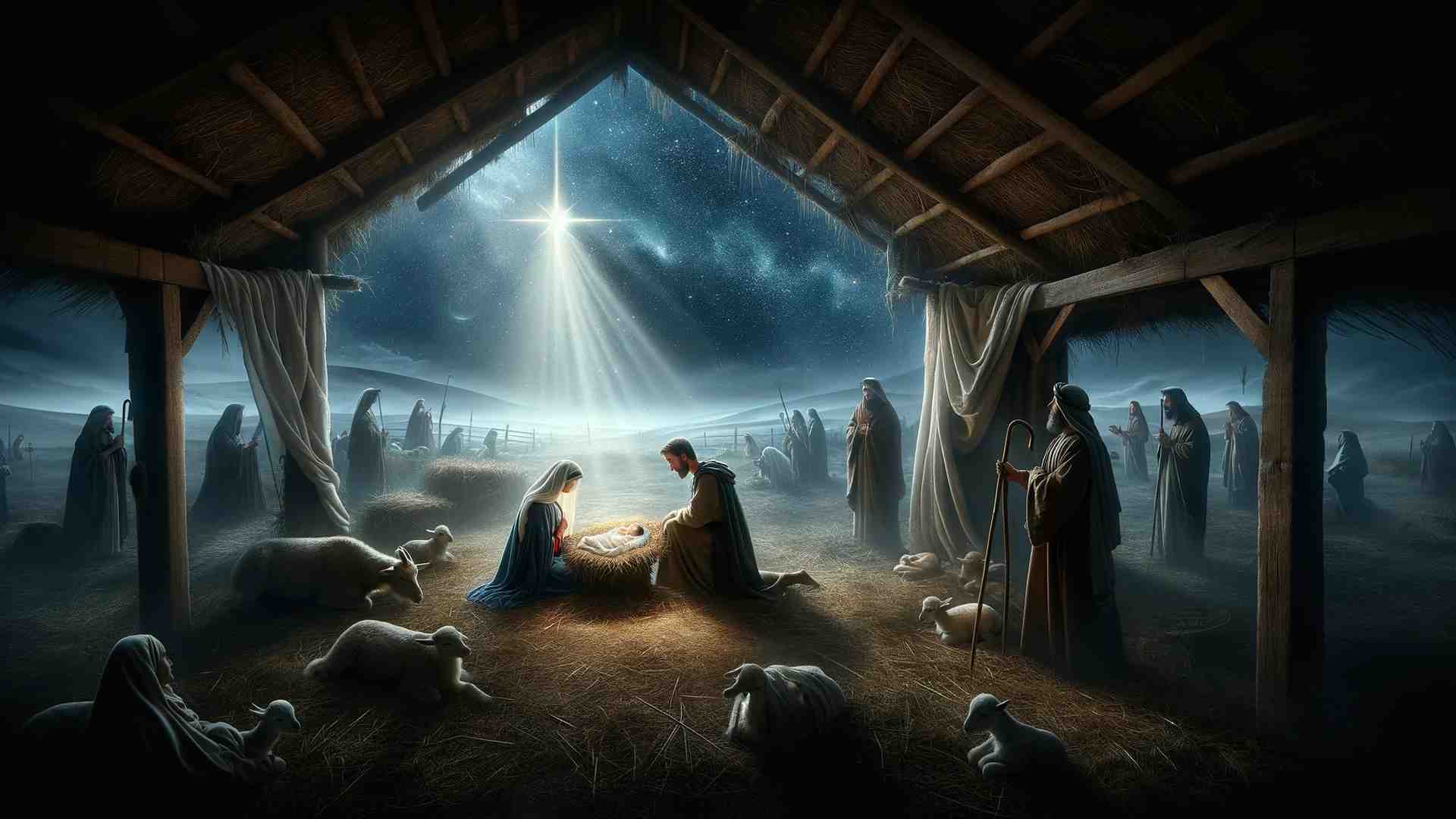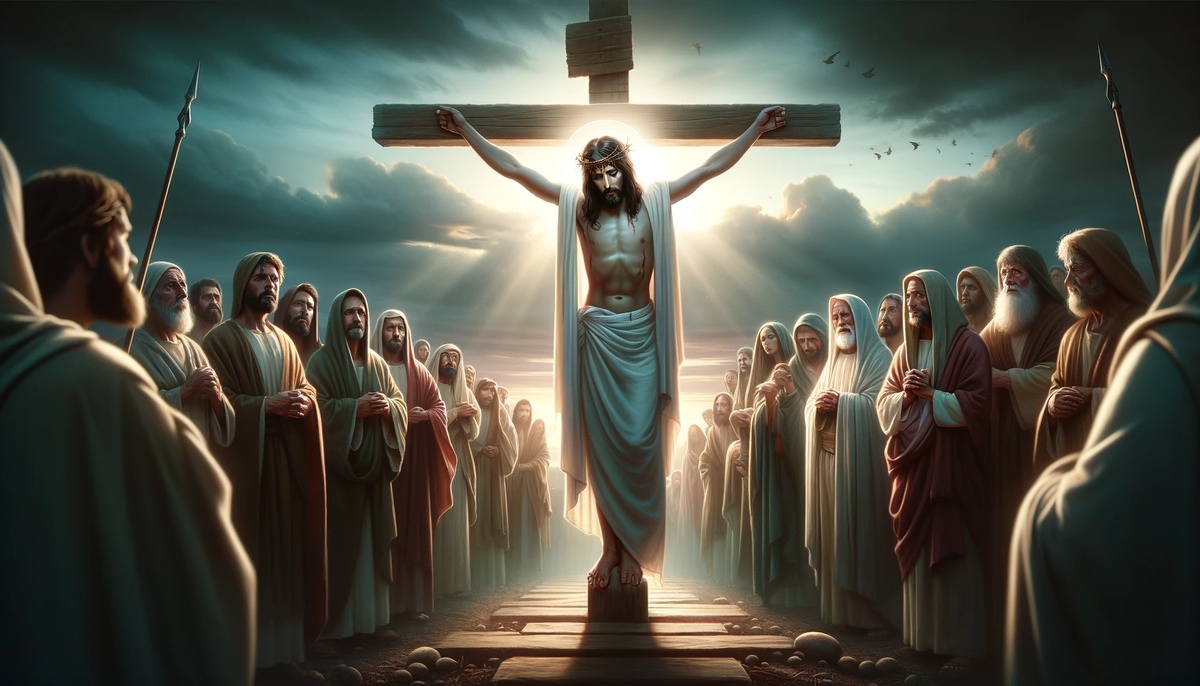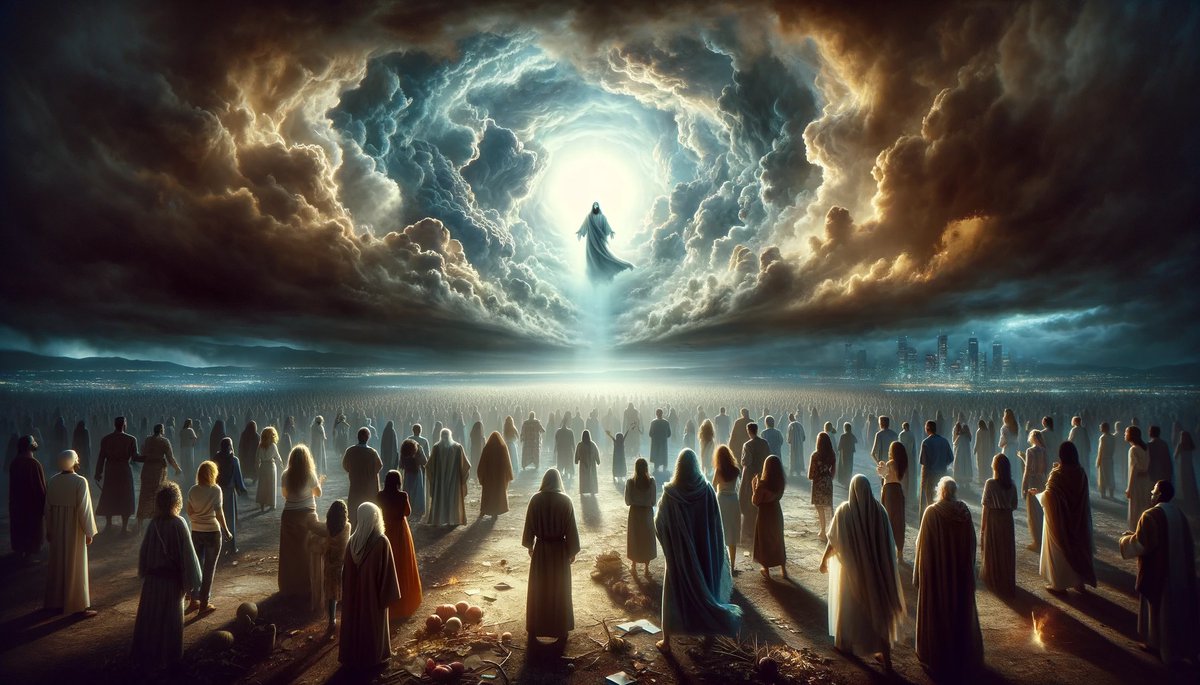Home>Christian Videos>Bible Stories>Why Did The Devil Come First And Not Jesus Christ In The Bible


Bible Stories
Why Did The Devil Come First And Not Jesus Christ In The Bible
Published: March 3, 2024
Ericka Andersen, an editor at Christian.net, expertly merges digital strategy with content creation, focusing on faith and societal issues. Her communication skills enhance the platform's engaging narratives, fostering meaningful dialogue on belief's impact on society.
Discover the significance of the devil's appearance before Jesus Christ in the Bible. Explore intriguing insights into biblical stories.
(Many of the links in this article redirect to a specific reviewed product. Your purchase of these products through affiliate links helps to generate commission for Christian.net, at no extra cost. Learn more)
Table of Contents
Introduction
Why did the Devil come first and not Jesus Christ in the Bible? This question has puzzled many believers and scholars alike. The order of appearance of these two significant figures in the Bible has sparked various interpretations and discussions within theological circles. In this article, we will delve into the concept of the Devil in the Bible, the role of Jesus Christ, and the theological interpretations of their respective arrivals. By exploring these aspects, we aim to shed light on the significance of their appearances in the biblical narrative.
Read more: How Did The Name “Jesus Christ” Come About
The Concept of the Devil in the Bible
The concept of the Devil in the Bible is deeply rooted in the Abrahamic faiths, particularly Christianity. The Devil, also known as Satan, is portrayed as a malevolent and deceptive entity who opposes God and tempts humans to sin. In the Old Testament, the Devil is depicted as a fallen angel who rebelled against God and was cast out of heaven. Throughout the Bible, the Devil is associated with cunning, evil, and the embodiment of sin. The Book of Genesis introduces the serpent, often interpreted as a manifestation of the Devil, tempting Eve to eat the forbidden fruit, thus leading to the fall of humanity. This portrayal sets the stage for the adversarial role of the Devil in the biblical narrative, where he continues to tempt and corrupt individuals in various accounts, symbolizing the struggle between good and evil.
The Devil's character in the Bible serves as a cautionary symbol, representing the allure of sin and the consequences of straying from God's path. The Devil's presence in the biblical text underscores the ongoing spiritual battle between righteousness and malevolence, emphasizing the need for faith, discernment, and moral fortitude. The Devil's influence is depicted as pervasive, seeking to undermine the divine order and lead humanity astray. This portrayal of the Devil as a malevolent force serves to highlight the significance of spiritual vigilance and the enduring struggle against temptation and moral corruption.
The Devil's role in the Bible is multifaceted, encompassing themes of temptation, spiritual warfare, and the testing of faith. The concept of the Devil in the Bible has contributed to the development of theological discourse surrounding the nature of evil, free will, and the human condition. Understanding the portrayal of the Devil in the biblical narrative provides insight into the complexities of human nature and the enduring struggle between good and evil as depicted in religious teachings and moral allegories.
The Role of Jesus Christ in the Bible
The role of Jesus Christ in the Bible is central to the Christian faith and holds profound significance in the narrative of salvation and redemption. Jesus Christ is portrayed as the Son of God, the Messiah, and the embodiment of divine love and compassion. His arrival on earth is heralded as the fulfillment of prophecies and the ultimate expression of God's grace and mercy towards humanity. The New Testament documents the life, teachings, crucifixion, and resurrection of Jesus Christ, emphasizing his role as the savior and mediator between God and humanity.
-
Redemption and Atonement: Jesus Christ's primary role in the Bible is to offer redemption and atonement for humanity's sins. His sacrificial death on the cross is viewed as the ultimate act of love, providing a path for reconciliation with God and the forgiveness of sins. The concept of atonement through the shedding of Christ's blood is central to Christian theology, emphasizing the transformative power of his sacrifice in restoring the broken relationship between humanity and God.
-
Teachings and Miracles: Jesus Christ's ministry is characterized by his profound teachings, parables, and miraculous acts. His ethical teachings, such as the Sermon on the Mount, emphasize love, compassion, forgiveness, and the Kingdom of God. The miracles attributed to Jesus, including healing the sick, raising the dead, and calming the storm, demonstrate his divine authority and compassion towards those in need, reinforcing his role as the embodiment of God's love and power.
-
Victory Over Death: The resurrection of Jesus Christ following his crucifixion is a pivotal event in the Bible, symbolizing victory over sin and death. His resurrection affirms the promise of eternal life and serves as a testament to the power of God's redemption. The resurrection of Jesus Christ solidifies his role as the conqueror of death and the source of hope for believers, underscoring the transformative impact of his life and teachings.
-
Mediator and Intercessor: Jesus Christ's role as the mediator between God and humanity is emphasized in Christian theology. He is depicted as the advocate for believers, interceding on their behalf before God. The concept of Christ's intercession underscores his role as the bridge between the divine and the human, offering comfort, guidance, and assurance of God's love and mercy.
-
Second Coming and Judgment: The Bible also portrays Jesus Christ's anticipated return, where he will judge the living and the dead. His second coming is associated with the fulfillment of God's plan for the world and the establishment of a new heaven and earth. The anticipation of Christ's return underscores his enduring role as the ultimate authority and the fulfillment of God's redemptive purpose for humanity.
The role of Jesus Christ in the Bible encompasses themes of salvation, divine love, and the restoration of humanity's relationship with God. His life, teachings, sacrificial death, and resurrection form the cornerstone of Christian faith, offering hope, reconciliation, and the promise of eternal life. Understanding the profound significance of Jesus Christ's role in the biblical narrative provides insight into the core tenets of Christian belief and the enduring impact of his message on the lives of believers.
Theological Interpretations of the Devil's Appearance
The Devil's appearance in the Bible has been the subject of theological interpretations and scholarly discourse within Christian theology. The timing and significance of the Devil's introduction in the biblical narrative have prompted various theological perspectives and interpretations. These interpretations seek to elucidate the role of the Devil in the divine plan, the nature of evil, and the implications of his presence in the overarching framework of Christian belief.
-
Symbol of Moral Choice: Some theological interpretations posit that the Devil's early appearance in the Bible serves as a symbolic representation of humanity's moral agency and the freedom to choose between good and evil. The presence of the Devil as a tempter in the Garden of Eden underscores the concept of free will and the moral responsibility of individuals to discern between righteousness and sin. This interpretation emphasizes the inherent capacity for moral choice and the consequences of yielding to temptation, thereby highlighting the significance of human agency in the unfolding of divine purpose.
-
Test of Faith and Virtue: Another theological perspective suggests that the Devil's early appearance serves as a test of faith and virtue for humanity. The adversarial role of the Devil is viewed as a means to demonstrate the steadfastness of human devotion to God and the resilience of faith in the face of temptation and spiritual adversity. This interpretation underscores the transformative nature of trials and challenges, emphasizing the cultivation of moral character and spiritual fortitude through the confrontation of malevolent influences.
-
Manifestation of Cosmic Conflict: Within theological discourse, the Devil's appearance is often interpreted as a manifestation of the cosmic conflict between the forces of good and evil. The presence of the Devil as an antagonist represents the broader theological theme of spiritual warfare and the enduring struggle between divine sovereignty and malevolent opposition. This interpretation underscores the overarching narrative of redemption and the ultimate triumph of God's sovereignty over the forces of darkness, thereby framing the Devil's appearance as a pivotal element in the cosmic drama of salvation.
-
Catalyst for Redemption: Some theological interpretations posit that the Devil's early appearance serves as a catalyst for the unfolding of God's redemptive plan for humanity. The temptation and fall of humanity instigated by the Devil's influence set the stage for the eventual manifestation of God's grace and mercy through the redemptive work of Jesus Christ. This perspective emphasizes the transformative power of divine intervention in response to the disruptive influence of the Devil, thereby framing the Devil's appearance as a precursor to the revelation of God's redemptive love and salvific purpose.
-
Symbol of Spiritual Adversity: The Devil's appearance in the early narrative of the Bible is also interpreted as a symbol of spiritual adversity and the pervasive nature of moral corruption. The portrayal of the Devil as a malevolent entity highlights the enduring struggle against temptation, sin, and spiritual opposition. This interpretation underscores the ongoing spiritual battle faced by individuals and the imperative of steadfast faith, moral discernment, and spiritual vigilance in resisting the allure of malevolence.
The theological interpretations of the Devil's appearance in the Bible offer diverse perspectives on the significance of his early introduction in the biblical narrative. These interpretations contribute to the broader theological discourse surrounding the nature of evil, human agency, divine sovereignty, and the redemptive purpose of God. Understanding the theological interpretations of the Devil's appearance provides insight into the complexities of moral and spiritual themes within Christian theology, enriching the understanding of the biblical narrative and its enduring relevance for believers.
Theological Interpretations of Jesus Christ's Arrival
The arrival of Jesus Christ in the biblical narrative has been the subject of profound theological interpretations and scholarly analysis within Christian theology. The timing and significance of Jesus Christ's advent have prompted diverse theological perspectives and interpretations, each seeking to elucidate the profound implications of his arrival in the overarching framework of Christian belief.
-
Fulfillment of Prophecy: One theological interpretation emphasizes that Jesus Christ's arrival fulfills the prophetic promises and expectations articulated in the Old Testament. The anticipation of the Messiah, foretold by the prophets, is seen as culminating in the incarnation of Jesus Christ. This interpretation underscores the continuity of God's redemptive plan throughout history and the fulfillment of divine promises through the arrival of the long-awaited Messiah.
-
Revelation of God's Love: Another theological perspective posits that Jesus Christ's arrival serves as a revelation of God's boundless love and compassion for humanity. The incarnation of Jesus Christ is viewed as the ultimate expression of God's desire to reconcile and redeem humanity, demonstrating the depth of divine love through the act of entering into human existence. This interpretation underscores the transformative impact of God's love manifested in the person of Jesus Christ.
-
Redemptive Mission: Within theological discourse, Jesus Christ's arrival is often interpreted as the commencement of his redemptive mission for humanity. His ministry, sacrificial death, and resurrection are viewed as integral components of God's plan for the salvation and restoration of humanity. This interpretation emphasizes the pivotal role of Jesus Christ in effecting reconciliation between God and humanity, thereby framing his arrival as the catalyst for the unfolding of God's redemptive purpose.
-
Incarnation and Divine Presence: Some theological interpretations highlight the significance of Jesus Christ's arrival as the incarnation of the divine within human history. The concept of the Word becoming flesh, as articulated in the Gospel of John, underscores the profound nature of Jesus Christ's arrival as the embodiment of God's presence among humanity. This interpretation emphasizes the transformative impact of the incarnation, affirming the divine solidarity with human experiences and the revelation of God's immanence.
-
Establishment of the Kingdom of God: The arrival of Jesus Christ is also interpreted within the framework of inaugurating the Kingdom of God on earth. His teachings, parables, and acts of compassion are seen as laying the foundation for the establishment of God's reign characterized by justice, mercy, and divine sovereignty. This interpretation underscores the transformative impact of Jesus Christ's arrival in ushering in the redemptive reign of God among humanity.
The theological interpretations of Jesus Christ's arrival in the biblical narrative offer diverse perspectives on the profound significance of his incarnation and ministry. These interpretations contribute to the broader theological discourse surrounding the themes of redemption, divine love, prophetic fulfillment, and the transformative impact of Jesus Christ's life and teachings. Understanding the theological interpretations of Jesus Christ's arrival provides insight into the foundational tenets of Christian faith and the enduring relevance of his message for believers.
Read more: Why Did Jesus Christ Die
Conclusion
In conclusion, the question of why the Devil came first and not Jesus Christ in the Bible has sparked profound theological interpretations and discussions within Christian theology. The concept of the Devil in the Bible serves as a cautionary symbol, representing the allure of sin and the consequences of straying from God's path. His presence underscores the ongoing spiritual battle between righteousness and malevolence, emphasizing the need for faith, discernment, and moral fortitude. On the other hand, the arrival of Jesus Christ is central to the narrative of salvation and redemption, heralded as the fulfillment of prophecies and the ultimate expression of God's grace and mercy towards humanity. His role as the savior and mediator between God and humanity encompasses themes of redemption, divine love, and the restoration of humanity's relationship with God.
The theological interpretations of the Devil's appearance and Jesus Christ's arrival offer diverse perspectives on the significance of their roles in the biblical narrative. These interpretations contribute to the broader theological discourse surrounding the nature of evil, human agency, divine sovereignty, and the redemptive purpose of God. Understanding these interpretations provides insight into the complexities of moral and spiritual themes within Christian theology, enriching the understanding of the biblical narrative and its enduring relevance for believers. Ultimately, the question of the order of their appearance in the Bible invites contemplation on the profound themes of good and evil, redemption, and the enduring impact of divine love and grace.














